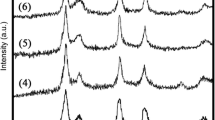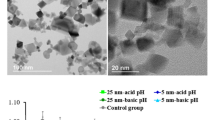Abstract
The current study describes the chemical production of CeO2 nanoparticles using co-precipitation, X-ray diffraction (XRD), Fourier transform infrared spectroscopy (FTIR), reflectance diffuse spectroscopy (RDS), and scanning electron microscopy (SEM). The degradation kinetics of violet crystal and methylene blue were investigated under UV and natural sunlight irradiation. X-ray diffraction analysis reveals that the purity and crystallinity of cerium oxide (CeO2) NPs are perfect. According to the Debye–Scherrer equation and the distribution of single and clustered particle SEM images, the CeO2 particle size of 51.12 nm is adequate. The CeO2 efficient photodegradation of methylene blue and crystal violet under UV and sunlight irradiation was tested. 100% of methylene blue was removed after 30 min in addition 95% of violet crystal degraded after 120 min of UV light exposition. Cerium oxide photocatalytic activity remained steady across five successive trials of UV irradiation. This method evaluates the physicochemical, mechanical stability, and reusability of the CeO2 photocatalyst.
Graphical abstract









Similar content being viewed by others
Data availability
The authors declare that the data supporting the findings of this study are available within the paper and its Supplementary Information files. Should any raw data files be needed in another format they are available from the corresponding author upon reasonable request. Source data are provided with this paper.
References
Islam MA, Ali I, Karim SMA et al (2019) Removal of dye from polluted water using novel nano manganese oxide-based materials. J Water Process Eng 32:1–23. https://doi.org/10.1016/j.jwpe.2019.100911
Ameen S, Seo HK, Shaheer Akhtar M, Shin HS (2012) Novel graphene/polyaniline nanocomposites and its photocatalytic activity toward the degradation of rose Bengal dye. Chem Eng J 210:220–228. https://doi.org/10.1016/j.cej.2012.08.035
Singh KP, Gupta S, Singh AK, Sinha S (2011) Optimizing adsorption of crystal violet dye from water by magnetic nanocomposite using response surface modeling approach. J Hazard Mater 186:1462–1473. https://doi.org/10.1016/j.jhazmat.2010.12.032
He H, Yang S, Yu K, Ju Y, Sun C, Wang L (2010) Microwave induced catalytic degradation of crystal violet in nano-nickel dioxide suspensions. J Hazard Mater 173:393
Hofmann U, Kottenhahn H, Morcos S (1966) Adsorption of methylene blue on clays. Angew Chemie Int Ed English 5:247–248. https://doi.org/10.1002/anie.196602473
Rokhsat E, Akhavan O (2016) Improving the photocatalytic activity of graphene oxide/ZnO nanorod films by UV irradiation. Appl Surf Sci 371:590–595. https://doi.org/10.1016/j.apsusc.2016.02.222
Soares SF, Simões TR, Trindade T, Daniel-da-Silva AL (2017) Highly efficient removal of dye from water using magnetic carrageenan/silica hybrid nano-adsorbents. Water Air Soil Pollut. https://doi.org/10.1007/s11270-017-3281-0
Sajid MM, Assaedi H, Zhai H (2023) Transition metal vanadates (MVO; M=Bi, Fe, Zn) synthesized by a hydrothermal method for efficient photocatalysis. J Mater Sci Mater Electron 34:1–16. https://doi.org/10.1007/s10854-023-09923-5
Bessoussa F, Ben NJ, Samet L, Chtourou R (2020) Controlled hydrothermal synthesis and solar light photocatalysis properties of branched Bi2S3/TiO2 nano-heterostructure. J Mater Sci Mater Electron 31:17980–17994. https://doi.org/10.1007/s10854-020-04350-2
Bijanzad K, Tadjarodi A, Moghaddasi Khiavi M, Akhavan O (2015) Microwave-assisted synthesis of bismuth oxybromochloride nanoflakes for visible light photodegradation of pollutants. Phys B Condens Matter 475:14–20. https://doi.org/10.1016/j.physb.2015.06.013
Fergani S, Zazoua H, Saadi A et al (2023) Activation of peroxymonosulfate by Co2SnO4/Co3O4/SnO2 material for the effective degradation of diclofenac. React Kinet Mech Catal. https://doi.org/10.1007/s11144-023-02381-4
Tanji K, El Mrabet I, Fahoul Y et al (2023) Experimental and theoretical investigation of enhancing the photocatalytic activity of Mg doped ZnO for nitrophenol degradation. React Kinet Mech Catal. https://doi.org/10.1007/s11144-023-02385-0
Alani OA, Alani SO, Ari HA et al (2022) Tetracycline degradation by efficient synergistic bio-templated CuO photocatalysis and Fenton hybrid process irradiated by visible light: influential parameters, and mechanisms. J Mater Sci Mater Electron 33:25603–25618. https://doi.org/10.1007/s10854-022-09258-7
Aslam M, Qamar MT, Soomro MT et al (2016) The effect of sunlight induced surface defects on the photocatalytic activity of nanosized CeO2 for the degradation of phenol and its derivatives. Appl Catal B Environ 180:391–402. https://doi.org/10.1016/j.apcatb.2015.06.050
Iqbal J, Shah NS, Khan ZUH et al (2022) Visible light driven doped CeO2 for the treatment of pharmaceuticals in wastewater: a review. J Water Process Eng. https://doi.org/10.1016/j.jwpe.2022.103130
Liu Y, Lu X, Wu F, Deng N (2011) Adsorption and photooxidation of pharmaceuticals and personal care products on clay minerals. React Kinet Mech Catal 104:61–73. https://doi.org/10.1007/s11144-011-0349-5
Karakurt H, Kartal OE (2022) Removal of reactive red 120 using immobilized TiO2 in the presence of UV light. React Kinet Mech Catal 135:2153–2173. https://doi.org/10.1007/s11144-022-02230-w
Bouafia A, Meneceur S, Chami S, Laouini SE, Daoudi H, Legmairi S, Mohammed Mohammed HA, Aoun N, Menaa F (2023) Removal of hydrocarbons and heavy metals from petroleum water by modern green nanotechnology methods. Sci Rep 13:5637. https://doi.org/10.1038/s41598-023-32938-1
Graham AR (1955) Cerianite CeO2: a new rare-earth oxide mineral. Am Mineral 40:560–564
Szucs AM, Maddin M, Brien D et al (2023) The role of nanocerianite (CeO2) in the stability of Ce carbonates at low-hydrothermal conditions. RSC Adv 13:6919–6935. https://doi.org/10.1039/d3ra00519d
Zarinkamar M, Farahmandjou M, Firoozabadi TP (2016) One-step synthesis of ceria (CeO2) nano-spheres by a simple wet chemical method. J Ceram Process Res 17:166–169
Hagfeldt A, Grätzel M (1995) Light-Induced redox reactions in nanocrystalline systems. Chem Rev 95:49–68. https://doi.org/10.1021/cr00033a003
Singh RP, Singh SL (1986) Electrodeposited semiconducting CuInSe2 films. II. Photo-electrochemical solar cells. J Phys D Appl Phys 19:1759–1769. https://doi.org/10.1088/0022-3727/19/9/020
Sharma D, Mehta BR (2018) Nanostructured TiO2 thin films sensitized by CeO2 as an inexpensive photoanode for enhanced photoactivity of water oxidation. J Alloys Compd 749:329–335. https://doi.org/10.1016/j.jallcom.2018.03.228
Safat S, Buazar F, Albukhaty S, Matroodi S (2021) Enhanced sunlight photocatalytic activity and biosafety of marine-driven synthesized cerium oxide nanoparticles. Sci Rep 11:1–11. https://doi.org/10.1038/s41598-021-94327-w
Magdalane CM, Kaviyarasu K, Vijaya JJ et al (2017) Evaluation on the heterostructured CeO2/Y2O3 binary metal oxide nanocomposites for UV/Vis light induced photocatalytic degradation of Rhodamine—B dye for textile engineering application. J Alloys Compd 727:1324–1337. https://doi.org/10.1016/j.jallcom.2017.08.209
Phuruangrat A, Thongtem S, Thongtem T (2017) Microwave-assisted hydrothermal synthesis and characterization of CeO2nanowires for using as a photocatalytic material. Mater Lett 196:61–63. https://doi.org/10.1016/j.matlet.2017.03.013
Tambat S, Umale S, Sontakke S (2016) Photocatalytic degradation of Milling Yellow dye using sol-gel synthesized CeO2. Mater Res Bull 76:466–472. https://doi.org/10.1016/j.materresbull.2016.01.010
Zhang C, Zhang X, Wang Y, Xie S, Liu Y, Lu X, Tong YNJC (2014) Facile electrochemical synthesis of CeO2 hierarchical nanorods and nanowires with excellent photocatalytic activities. New J Chem 38:2581–2586
Aslam M, Qamar MT, Soomro MT, Ismail IMI, Salah N, Almeelbi T, Gondal MA, Hameed A (2016) The effect of sunlight induced surface defects on the photocatalytic activity of nanosized CeO2 for degradation of phenol and its derivatives. Appl Catal B Environ 180:391–402
Khan MM, Ansari SA, Pradhan D et al (2014) Defect-induced band gap narrowed CeO2 nanostructures for visible light activities. Ind Eng Chem Res 53:9754–9763. https://doi.org/10.1021/ie500986n
Amoresi RAC, Oliveira RC, Marana NL, de Almeida PB, Prata PS, Zaghete MA, Longo E, Sambrano JR, Simoes AZ (2019) CeO2 nanoparticle morphologies and their corresponding crystalline planes for Pollutants., the photocatalytic degradation of organic. ACS Appl Nano Mater 2:6513–6526
Sebastiammal S, Mariappan A, Neyvasagam K, Fathima AL (2019) ScienceDirect annona muricata inspired synthesis of CeO2 nanoparticles and their antimicrobial activity. Mater Today: Proc 9:627–632. https://doi.org/10.1016/j.matpr.2018.10.385
Phokha S, Hunpratub S, Usher B et al (2018) Applied surface science effects of CeO2 nanoparticles on electrochemical properties of carbon/CeO2 composites. Appl Surf Sci. https://doi.org/10.1016/j.apsusc.2018.02.209
Guo M, Guo C, Jin L et al (2010) Nano-sized CeO2 with extra-high surface area and its activity for CO oxidation. Mater Lett 64:1638–1640. https://doi.org/10.1016/j.matlet.2010.04.018
Schlumberger C, Thommes M (2021) Characterization of hierarchically ordered porous materials by physisorption and mercury porosimetry—a tutorial review. Adv Mater Interfaces. https://doi.org/10.1002/admi.202002181
Li Q, Liu L, Wang Z, Wang X (2022) Continuous hydrothermal flow synthesis and characterization of ZrO2 nanoparticles doped with CeO2 in supercritical water. Nanomaterials. https://doi.org/10.3390/nano12040668
Khosravikia M, Rahbar-Kelishami A (2022) A simulation study of an applied approach to enhance drug recovery through electromembrane extraction. J Mol Liq 358:119210. https://doi.org/10.1016/j.molliq.2022.119210
Fukahori S, Fujiwara T, Ito R, Funamizu N (2011) PH-Dependent adsorption of sulfa drugs on high silica zeolite: modeling and kinetic study. Desalination 275:237–242. https://doi.org/10.1016/j.desal.2011.03.006
Abid HN, Al-keisy A, Ahmed DS et al (2022) pH dependent synthesis and characterization of bismuth molybdate nanostructure for photocatalysis degradation of organic pollutants. Environ Sci Pollut Res 29:37633–37643. https://doi.org/10.1007/s11356-021-18064-3
Neppolian B, Choi HC, Sakthivel S et al (2002) Solar light induced and TiO2 assisted degradation of textile dye reactive blue 4. Chemosphere 46:1173–1181. https://doi.org/10.1016/S0045-6535(01)00284-3
Damodar RA, Jagannathan K, Swaminathan T (2007) Decolourization of reactive dyes by thin film immobilized surface photoreactor using solar irradiation. Sol Energy 81:1–7. https://doi.org/10.1016/j.solener.2006.07.001
Amani H, Habibey R, Hajmiresmail SJ et al (2017) Antioxidant nanomaterials in advanced diagnoses and treatments of ischemia reperfusion injuries. J Mater Chem B 5:9452–9476
Wu H, Shabala L, Shabala S, Giraldo JP (2018) Hydroxyl radical scavenging by cerium oxide nanoparticles improves Arabidopsis salinity tolerance by enhancing leaf mesophyll potassium retention. Environ Sci Nano 5:1567–1583. https://doi.org/10.1039/c8en00323h
Zhang Q, Chen J, Gao X et al (2022) Understanding the mechanism of interfacial interaction enhancing photodegradation rate of pollutants at molecular level : Intermolecular π—π interactions favor electrons delivery. J Hazard Mater 430:128386. https://doi.org/10.1016/j.jhazmat.2022.128386
Pouretedal HR, Kadkhodaie A (2010) Synthetic CeO2 nanoparticle catalysis of methylene blue photodegradation : kinetics and mechanism. Chinese J Catal 31:1328–1334. https://doi.org/10.1016/S1872-2067(10)60121-0
Wandre TM, Gaikwad PN, Tapase AS et al (2016) Sol – gel synthesized TiO 2—CeO2 nanocomposite : an efficient photocatalyst for degradation of methyl orange under sunlight. J Mater Sci Mater Electron 27:825–833. https://doi.org/10.1007/s10854-015-3823-4
Liu X, Meng F, Yu B, Wu H (2020) Self - assembly synthesis of flower—like—CeO2/MoS 2 heterojunction with enhancement of visible light photocatalytic activity for methyl orange. J Mater Sci: Mater Electron. https://doi.org/10.1007/s10854-020-03225-w
Wen X, Zhang C, Niu C et al (2017) Highly enhanced visible light photocatalytic activity of CeO2 through fabricating a novel p—n junction BiOBr/CeO2. Catal Commun 90:51–55. https://doi.org/10.1016/j.catcom.2016.11.018
Ji P, Zhang J, Chen F, Anpo M (2009) Study of adsorption and degradation of acid orange 7 on the surface of CeO2 under visible light irradiation. Appl Catal B Environ 85:148–154. https://doi.org/10.1016/j.apcatb.2008.07.004
Channei D, Nakaruk A, Phanichphant S (2017) Photocatalytic degradation of dye using CeO2/SCB composite catalysts. Spectrochim Acta—Part A Mol Biomol Spectrosc 183:218–224. https://doi.org/10.1016/j.saa.2017.04.063
Murugadoss G, Ma J, Ning X, Kumar MR (2019) Selective metal ions doped CeO2 nanoparticles for excellent photocatalytic activity under sun light and supercapacitor application. Inorg Chem Commun. https://doi.org/10.1016/j.inoche.2019.107577
Mao C, Zhao Y, Qiu X, Zhu J, Burda C (2008) Synthesis, characterization and computational study of nitrogen-doped CeO2 nanoparticles with visible-light activity. Phys Chem Chem Phys 10:5633–5638
Acknowledgements
The authors acknowledge the Ministry of Higher Education and Scientific Research of Algeria, Jijel University for their financial support.
Author information
Authors and Affiliations
Corresponding author
Additional information
Publisher's Note
Springer Nature remains neutral with regard to jurisdictional claims in published maps and institutional affiliations.
Supplementary Information
Below is the link to the electronic supplementary material.
Rights and permissions
Springer Nature or its licensor (e.g. a society or other partner) holds exclusive rights to this article under a publishing agreement with the author(s) or other rightsholder(s); author self-archiving of the accepted manuscript version of this article is solely governed by the terms of such publishing agreement and applicable law.
About this article
Cite this article
Aoun, N., Boucheloukh, H., Belkhalfa, H. et al. Combined action of cerianite, uv and direct sunlight irradiation for the removal of violet crystal and methylene blue from aqueous solution. Reac Kinet Mech Cat 136, 1607–1623 (2023). https://doi.org/10.1007/s11144-023-02410-2
Received:
Accepted:
Published:
Issue Date:
DOI: https://doi.org/10.1007/s11144-023-02410-2




